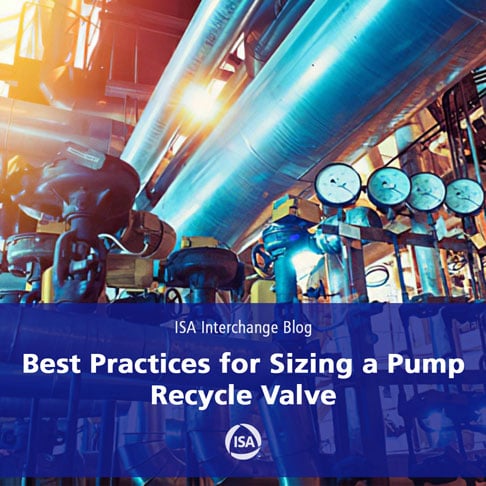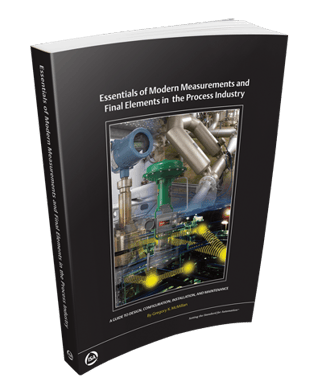The following technical discussion is part of an occasional series showcasing the ISA Mentor Program, authored by Greg McMillan, industry consultant, author of numerous process control books, 2010 ISA Life Achievement Award recipient and retired Senior Fellow from Solutia Inc. (now Eastman Chemical). Greg will be posting questions and responses from the ISA Mentor Program, with contributions from program participants.
In the ISA Mentor Program, I am providing guidance for extremely talented individuals from countries such as Argentina, Brazil, Malaysia, Mexico, Saudi Arabia, and the USA. This question comes from Muhammad Al-Khalifah in Saudi Arabia. .
Muhammad Al-Khalifah's Question
What are the best practices used for sizing a pump recycle valve?

Hunter Vegas' Answer
The best practices will depend upon the details of your specific situation, but I can offer some general comments about the recycle valve. Recycle valves are usually used to maintain some limited flow through a pump to avoid cavitation under dead-head or low flow conditions. Some plants just install a recycle line with a restriction orifice in it that is sized to pass the minimum flow to avoid pump cavitation and let it recycle all the time. Of course, this is wasteful, especially if the pump is normally NOT deadheaded and requires no recycle at all.
Another option is to install a control valve that can pass the minimum flow to avoid pump cavitation and only open this valve when the pump is approaching dead-head conditions. The trick is to determine WHEN the pump is reaching those conditions as there is rarely a flow meter on the pump that will read the total flow through the pump (including the recycle). Some people just measure pump discharge pressure but if the suction pressure can change (such as from rising/falling upstream suction tank levels) then it can be difficult to determine when a recycle is required. Other options include monitoring the downstream valves and opening the recycle valve based on their positions or monitoring the downstream flow meters and just popping open the recycle fully when the flow is too low.
As far as sizing, you can start by consulting the pump manufacturer and finding the minimum flow the pump requires avoiding damage at dead-head conditions...then size your control valve for that flow with an inlet pressure equal to the pump dead head discharge pressure and an outlet pressure equal to the pressure at the recycle return point. (This may be the pump suction or the suction tank pressure). Note that these pressure drops can be considerable and flashing or cavitation across the valve is likely. I have even seen some people add a restriction orifice at the point where the recycle returns to the tank that is sized to take the bulk of the drop and flash the product back into the tank...and then size the control valve to take a smaller drop. However this only works if the recycle valve is more of an on/off valve rather than a throttling one.
One last comment – if your recycle valve is an anti-surge valve then this is a MUCH more complicated situation and requires a lot more detail to determine the proper sizing of the valve and actuator. If your question involves that type of valve, let me know.
ISA Mentor Program
The ISA Mentor Program enables young professionals to access the wisdom and expertise of seasoned ISA members, and offers veteran ISA professionals the chance to share their wisdom and make a difference in someone’s career. Click this link to learn more about the ISA Mentor Program.
Greg McMillan's Answer
Figures noted below are from the ISA book, Essentials of Modern Measurements and Final Elements in the Process Industry.

You might find an operating point on the pump curve for the highest static pressure that will handle the highest demand for flow downstream plus some minimum recycle flow for the dead-headed condition that would keep the recycle valve near a minimum throttle position (e.g., 10 percent for a sliding stem valve). You could use this pressure as the setpoint for a pressure loop that would continuously adjust the recycle flow to maintain a constant pump discharge pressure. The recycle valve should be in the suggested throttle range for the type of valve (see Figures 7-48a-c on pages 412-413 for three major types of valves). The valve pressure drop is the pump discharge pressure minus the return destination pressure minus the frictional losses in the pipeline.
The recycle flow will increase considerably wasting energy when there is a low demand for flow downstream. You could add a valve position controller (VPC) as described in my Control magazine article, Don’t Over Look PID for APC to minimize the pump discharge pressure setpoint by seeking to keep the recycle valve at a minimum throttle position. The VPC set point is minimum throttle position for the valve type, the VPC process variable is recycle valve position, and the VPC output is recycle pressure controller setpoint.
This VPC must be fast enough to handle abrupt increases in flow demand downstream so directional velocity limits in the analog output block with dynamic reset limit in the PID block would enable a fast response to close the recycle valve but a slow response to open the recycle valve without re-tuning. The dynamic reset limit is called “external-reset feedback” as described in Shinskey’s Control magazine article The power of external-reset feedback. If you don’t have the dynamic reset limit option offered in your PID, Gain scheduling of the VPC can accomplish something similar.
Additional Mentor Program Resources
See the ISA book 101 Tips for a Successful Automation Career that grew out of this Mentor Program to gain concise and practical advice. See the InTech magazine feature article Enabling new automation engineers for candid comments from some of the original program participants. See the Control Talk column How to effectively get engineering knowledge with the ISA Mentor Program protégée Keneisha Williams on the challenges faced by young engineers today, and the column How to succeed at career and project migration with protégé Bill Thomas on how to make the most out of yourself and your project. Providing discussion and answers besides Greg McMillan and co-founder of the program Hunter Vegas (project engineering manager at Wunderlich-Malec) are resources Mark Darby (principal consultant at CMiD Solutions), Brian Hrankowsky (consultant engineer at a major pharmaceutical company), Michel Ruel (executive director, engineering practice at BBA Inc.), Leah Ruder (director of global project engineering at the Midwest Engineering Center of Emerson Automation Solutions), Nick Sands (ISA Fellow and Manufacturing Technology Fellow at DuPont), Bart Propst (process control leader for the Ascend Performance Materials Chocolate Bayou plant), Angela Valdes (automation manager of the Toronto office for SNC-Lavalin), and Daniel Warren (senior instrumentation/electrical specialist at D.M.W. Instrumentation Consulting Services, Ltd.).
About the Author
Gregory K. McMillan, CAP, is a retired Senior Fellow from Solutia/Monsanto where he worked in engineering technology on process control improvement. Greg was also an affiliate professor for Washington University in Saint Louis. Greg is an ISA Fellow and received the ISA Kermit Fischer Environmental Award for pH control in 1991, the Control magazine Engineer of the Year award for the process industry in 1994, was inducted into the Control magazine Process Automation Hall of Fame in 2001, was honored by InTech magazine in 2003 as one of the most influential innovators in automation, and received the ISA Life Achievement Award in 2010. Greg is the author of numerous books on process control, including Advances in Reactor Measurement and Control and Essentials of Modern Measurements and Final Elements in the Process Industry. Greg has been the monthly "Control Talk" columnist for Control magazine since 2002. Presently, Greg is a part time modeling and control consultant in Technology for Process Simulation for Emerson Automation Solutions specializing in the use of the virtual plant for exploring new opportunities. He spends most of his time writing, teaching and leading the ISA Mentor Program he founded in 2011.
Connect with Greg:
The best practices will depend upon the details of your specific situation, but I can offer some general comments about the recycle valve. Recycle valves are usually used to maintain some limited flow through a pump to avoid cavitation under dead-head or low flow conditions. Some plants just install a recycle line with a restriction orifice in it that is sized to pass the minimum flow to avoid pump cavitation and let it recycle all the time. Of course, this is wasteful, especially if the pump is normally NOT deadheaded and requires no recycle at all.
Another option is to install a control valve that can pass the minimum flow to avoid pump cavitation and only open this valve when the pump is approaching dead-head conditions. The trick is to determine WHEN the pump is reaching those conditions as there is rarely a flow meter on the pump that will read the total flow through the pump (including the recycle). Some people just measure pump discharge pressure but if the suction pressure can change (such as from rising/falling upstream suction tank levels) then it can be difficult to determine when a recycle is required. Other options include monitoring the downstream valves and opening the recycle valve based on their positions or monitoring the downstream flow meters and just popping open the recycle fully when the flow is too low.
As far as sizing, you can start by consulting the pump manufacturer and finding the minimum flow the pump requires avoiding damage at dead-head conditions...then size your control valve for that flow with an inlet pressure equal to the pump dead head discharge pressure and an outlet pressure equal to the pressure at the recycle return point. (This may be the pump suction or the suction tank pressure). Note that these pressure drops can be considerable and flashing or cavitation across the valve is likely. I have even seen some people add a restriction orifice at the point where the recycle returns to the tank that is sized to take the bulk of the drop and flash the product back into the tank...and then size the control valve to take a smaller drop. However this only works if the recycle valve is more of an on/off valve rather than a throttling one.
One last comment – if your recycle valve is an anti-surge valve then this is a MUCH more complicated situation and requires a lot more detail to determine the proper sizing of the valve and actuator. If your question involves that type of valve, let me know.




